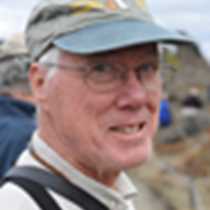Near the tip of the Antarctic Peninsula
We awoke this morning in a crystal cathedral called Antarctic Sound, just off the tip of the Antarctic Peninsula. It is an area known as Iceberg Alley, where large icebergs carried by the Weddell Sea gyre squeeze between the Peninsula and the adjacent islands. In recent years the catastrophic breakup of ice shelves bordering the Weddell Sea has spawned an enormous number of tabular bergs. Our ship gracefully navigated between and around them as we marveled at their size, shapes, and color. We passed one berg that was two nautical miles in length and towered well above our tallest mast; the water that it contains would satisfy all of the needs of Endeavour for roughly seventy-five thousand years, give or take an extra hot shower.
Our experience in Antarctica began with beautiful, clear weather, and so today it ended, albeit with a bit more Antarctic breeze. Our morning landing was at Kinnes Cove, an inlet surrounded by ice descending from the glaciers that cover Joinville Island. Some climbed a steep snow slope to a rocky promontory, for the reward of a spectacular view over Antarctic Sound. Others took to the kayaks to circumnavigate a rocky islet covered with nesting penguins. Yet others cruised by Zodiac around the ice-strewn inlet, where adelie penguins popped from the water to rest on the ice.
Our afternoon and final landing was on Gourdin Island, one of the few sites where all three species of brush-tail penguins (adelie, gentoo, and chinstrap) coexist. A penguin colony is a busy and noisy place! It was a time to find a comfortable spot to sit or stand and watch the activity, the comings and goings of the colony: birds massing on the shore in preparation for a feeding excursion, and returning full of krill for the young; climbing and hopping over the rocky slope to reach the nest; a brief but raucous greeting with the mate; the change-over at the nest, and then the delivery of food to the two hungry chicks while the mate departed for its turn at feeding. It takes all the time and effort that two adults can manage to successfully raise one or two young yearly. In future years, wherever we might find ourselves in the Holiday season, we can rejoice that penguins are again sending their voices into the clear air of Antarctica.
We awoke this morning in a crystal cathedral called Antarctic Sound, just off the tip of the Antarctic Peninsula. It is an area known as Iceberg Alley, where large icebergs carried by the Weddell Sea gyre squeeze between the Peninsula and the adjacent islands. In recent years the catastrophic breakup of ice shelves bordering the Weddell Sea has spawned an enormous number of tabular bergs. Our ship gracefully navigated between and around them as we marveled at their size, shapes, and color. We passed one berg that was two nautical miles in length and towered well above our tallest mast; the water that it contains would satisfy all of the needs of Endeavour for roughly seventy-five thousand years, give or take an extra hot shower.
Our experience in Antarctica began with beautiful, clear weather, and so today it ended, albeit with a bit more Antarctic breeze. Our morning landing was at Kinnes Cove, an inlet surrounded by ice descending from the glaciers that cover Joinville Island. Some climbed a steep snow slope to a rocky promontory, for the reward of a spectacular view over Antarctic Sound. Others took to the kayaks to circumnavigate a rocky islet covered with nesting penguins. Yet others cruised by Zodiac around the ice-strewn inlet, where adelie penguins popped from the water to rest on the ice.
Our afternoon and final landing was on Gourdin Island, one of the few sites where all three species of brush-tail penguins (adelie, gentoo, and chinstrap) coexist. A penguin colony is a busy and noisy place! It was a time to find a comfortable spot to sit or stand and watch the activity, the comings and goings of the colony: birds massing on the shore in preparation for a feeding excursion, and returning full of krill for the young; climbing and hopping over the rocky slope to reach the nest; a brief but raucous greeting with the mate; the change-over at the nest, and then the delivery of food to the two hungry chicks while the mate departed for its turn at feeding. It takes all the time and effort that two adults can manage to successfully raise one or two young yearly. In future years, wherever we might find ourselves in the Holiday season, we can rejoice that penguins are again sending their voices into the clear air of Antarctica.




